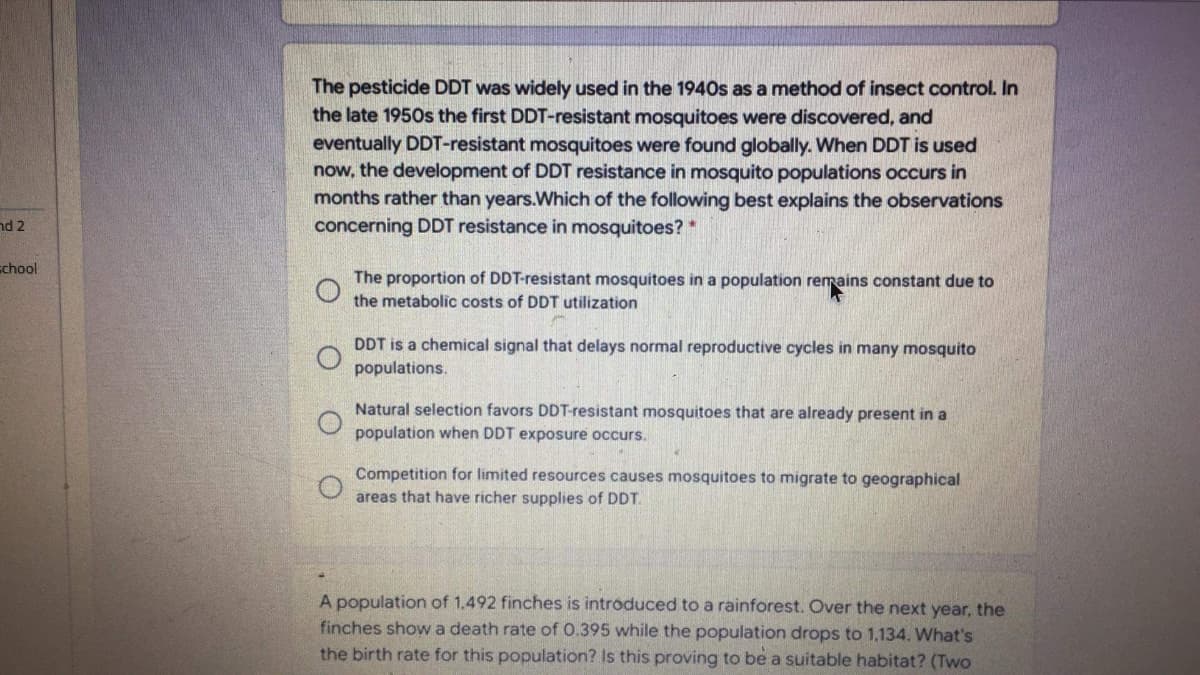The pesticide DDT was widely used in the 1940s as a method of insect control. In the late 1950s the first DDT-resistant mosquitoes were discovered, and eventually DDT-resistant mosquitoes were found globally. When DDT is used now, the development of DDT resistance in mosquito populations occurs in months rather than years.Which of the following best explains the observations concerning DDT resistance in mosquitoes? * The proportion of DDT-resistant mosquitoes in a population remains constant due to the metabolic costs of DDT utilization DDT is a chemical signal that delays normal reproductive cycles in many mosquito populations. Natural selection favors DDT-resistant mosquitoes that are already present in a population when DDT exposure occurs. Competition for limited resources causes mosquitoes to migrate to geographical areas that have richer supplies of DDT. A population of 1,492 finches is introduced to a rainforest. Over the next year, the finches show a death rate of 0.395 while the population drops to 1,134. What's the birth rate for this population? Is this proving to be a suitable habitat? (Two
The pesticide DDT was widely used in the 1940s as a method of insect control. In the late 1950s the first DDT-resistant mosquitoes were discovered, and eventually DDT-resistant mosquitoes were found globally. When DDT is used now, the development of DDT resistance in mosquito populations occurs in months rather than years.Which of the following best explains the observations concerning DDT resistance in mosquitoes? * The proportion of DDT-resistant mosquitoes in a population remains constant due to the metabolic costs of DDT utilization DDT is a chemical signal that delays normal reproductive cycles in many mosquito populations. Natural selection favors DDT-resistant mosquitoes that are already present in a population when DDT exposure occurs. Competition for limited resources causes mosquitoes to migrate to geographical areas that have richer supplies of DDT. A population of 1,492 finches is introduced to a rainforest. Over the next year, the finches show a death rate of 0.395 while the population drops to 1,134. What's the birth rate for this population? Is this proving to be a suitable habitat? (Two
Biology Today and Tomorrow without Physiology (MindTap Course List)
5th Edition
ISBN:9781305117396
Author:Cecie Starr, Christine Evers, Lisa Starr
Publisher:Cecie Starr, Christine Evers, Lisa Starr
Chapter12: Processes Of Evolution
Section: Chapter Questions
Problem 4DID
Related questions
Question

Transcribed Image Text:The pesticide DDT was widely used in the 1940s as a method of insect control. In
the late 1950s the first DDT-resistant mosquitoes were discovered, and
eventually DDT-resistant mosquitoes were found globally. When DDT is used
now, the development of DDT resistance in mosquito populations occurs in
months rather than years.Which of the following best explains the observations
concerning DDT resistance in mosquitoes? *
nd 2
school
The proportion of DDT-resistant mosquitoes in a population remains constant due to
the metabolic costs of DDT utilization
DDT is a chemical signal that delays normal reproductive cycles in many mosquito
populations.
Natural selection favors DDT-resistant mosquitoes that are already present in a
population when DDT exposure occurs.
Competition for limited resources causes mosquitoes to migrate to geographical
areas that have richer supplies of DDT.
A population of 1.492 finches is introduced to a rainforest. Over the next year, the
finches showa death rate of 0.395 while the population drops to 1.134. What's
the birth rate for this population? Is this proving to be a suitable habitat? (Two
Expert Solution
This question has been solved!
Explore an expertly crafted, step-by-step solution for a thorough understanding of key concepts.
This is a popular solution!
Trending now
This is a popular solution!
Step by step
Solved in 2 steps

Knowledge Booster
Learn more about
Need a deep-dive on the concept behind this application? Look no further. Learn more about this topic, biology and related others by exploring similar questions and additional content below.Recommended textbooks for you

Biology Today and Tomorrow without Physiology (Mi…
Biology
ISBN:
9781305117396
Author:
Cecie Starr, Christine Evers, Lisa Starr
Publisher:
Cengage Learning

Biology: The Unity and Diversity of Life (MindTap…
Biology
ISBN:
9781337408332
Author:
Cecie Starr, Ralph Taggart, Christine Evers, Lisa Starr
Publisher:
Cengage Learning

Biology Today and Tomorrow without Physiology (Mi…
Biology
ISBN:
9781305117396
Author:
Cecie Starr, Christine Evers, Lisa Starr
Publisher:
Cengage Learning

Biology: The Unity and Diversity of Life (MindTap…
Biology
ISBN:
9781337408332
Author:
Cecie Starr, Ralph Taggart, Christine Evers, Lisa Starr
Publisher:
Cengage Learning